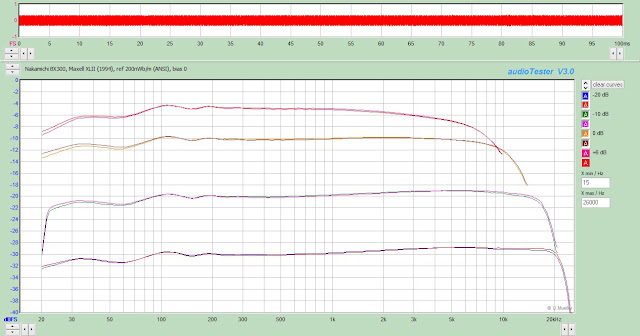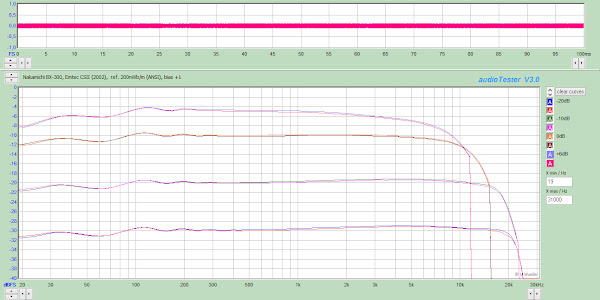Historically BASF was a long-time advocate of chromium dioxide, against all odds, and despite chrome's known and then-unknown drawbacks, pushing this tape technology until the early 1990s.
In 1987 BASF made a one-off excursion into ferro-cobalt land by creating the new IEC II Primary Reference tape, U564W, by all accounts a (noisy) TDK SA clone. This was quickly followed with the Reference Super II, a much better cassette, but short lived due to severe reliability problems.
Eventually by 1993 the call for a temperature-tolerant pigment for car audio caused the whole-hearted embracement of ferro-cobalt in the new TPII, and by 1995 about all previous chrome tape models were made with ferro-cobalt, despite there still appearing 'chrome' in their names.
All cassettes were erased in a Weircliffe
BKE200 prior to testing. The tests were done on a modified Nakamichi BX-300 with known playback response. The test procedures are explained in detail here.
INDEX OF ALL CASSETTES
Maxell XLII 90 (1994) (my calibration reference)
Relative bias: (reference)Relative sensitivity: (reference)
THD @ Dolby level: 0.62%
MOL400(THD=1%) : +1.8dB
MOL400(THD=3%): +5.3dB
MOL1k(THD=3%): +5.5dB
SOL10k: -3.4dB
Bias noise: -54.8dB, -59.2dB(A)
Dynamic range: 64.5dB
I repeat here the results for the tape my Nak BX-300 is calibrated for in type II position, the 1994 XLII. All following results take this as reference.
BASF IEC II Primary Reference U564W (1987)
Relative bias: -1Relative sensitivity: +1.1dB
THD @ Dolby level: 0.71%
MOL400(1%): +1.6dB
MOL400(3%): +5.9dB
MOL1k(3%): +5.8dB
SOL10k: -2.5dB
Bias noise: -51.6dB, -55.2dB(A)
Dynamic range: 61.1dB
End of 2021 I finally could lay hands on two genuine Primary Reference tapes, the 1994 type I Y384M and the 1987 type II U564W. These come from pancakes originally owned by a Philips production facility. The current owner, HPR, offers sections of these tapes loaded into NOS TEAC or BASF shells.
IEC Type II Primary Reference BASF U546W datasheet.
Observe how the datasheet specifies a much lower bias noise than I (or others) measure. This is a mystery. The short-lived BASF Reference Super II cassette, also of 1987, appeared to be identical to U564W, but with lower noise. The plot thickens ...
BASF Reference Maxima TP II (1993)
Relative bias: +0.5Relative sensitivity: +0.6dB
THD @ Dolby level: 0.35%
MOL400(1%): +3.7dB
MOL400(3%): +7.0 dB
MOL1k(3%): +6.3dB
SOL10k: -3.0dB
Bias noise: -53.7dB, -57.6dB(A)
Dynamic range: 64.6dB
It is known that BASF experimented around this time with Maxell XLII-S Black Magnetite pigment. It is not clear if any of this made it to BASF product in the stores. This said, this early TPII sample measures almost exactly like 1991 XLII-S.
More background stories http://www.tapeheads.net/showthread.php?t=18245, http://www.tapeheads.net/showthread.php?t=31289.
BASF Reference Maxima TP II (1995)
Relative bias: -1Relative sensitivity: +0.3dB
THD @ Dolby level: 0.44%
MOL400(1%): +2.7dB
MOL400(3%): +6.0dB
MOL1k(3%): +5.7dB
SOL10k: -3.8dB
Bias noise: -54.8dB, -58.7dB(A)
Dynamic range: 64.7dB
This is BASF's own take. Compared to the Maxell-inspired tape levels are down, and noise as well, netting a similar dynamic range.
BASF Chrome Super II (1995)
Relative bias: 0Relative sensitivity: +0.1dB
THD @ Dolby level: 0.82%
MOL400(1%): +0.8dB
MOL400(3%): +5.0dB
MOL1k(3%): +4.7dB
SOL10k: -3.0dB
Bias noise: -53.2dB, -57.3dB(A)
Dynamic range: 62.3dB
Perfectly interchangeable with XLII, but maximum output levels are a bit lower and noise is a bit higher. Do note that until Spring 1996 BASF also loaded chromium dioxide tape in these shells, alongside the ferro-cobalt tested here.
BASF Chrome Super Quality II (1997)

Relative bias: -1.5
Relative sensitivity: +0.5dB
THD @ Dolby level: 0.71%
MOL400(1%): +1.5dB
MOL400(3%): +5.3dB
MOL1k(3%): +5.5dB
SOL10k: -3.7dB
Bias noise: -53.4dB, -57.3dB(A)
Dynamic range: 62.6dB
Chrome Super Quality II was a series specifically made for a supermarket chain. It originated in the shape presented here in 1997. My version carries BASF branding together with an EMTEC company address, and was made in 1998. This is clearly a ferro-cobalt tape, with its compatibility parameters close to U564W or TDK SA.
BASF Chrome Extra II (1999)
Relative bias: -1Relative sensitivity: +0.7dB
THD @ Dolby level: 0.75%
MOL400(1%): +1.4dB
MOL400(3%): +5.4dB
MOL1k(3%): +5.6dB
SOL10k: -3.3dB
Bias noise: -52.9dB, -56.7dB(A)
Dynamic range: 62.1dB
This generation of CEII seemed to be another contender for the elusive chrome-plus-cobalt mixture. It originated in 1995 and spawned many iterations with near-identical looks, this during the tumultuous times when BASF's magnetics division got spun off and sold, carrying on under the EMTEC brand name. My sample dates from late 2000. The tape seems to be identical to 1997 Chrome Super Quality II, and the highish bias noise and the higher MOL show that there is certainly no chrome on board.
BASF 353 CRII Studio (1994)
Relative bias: -1.5
Relative sensitivity: -0.2dB
THD @ Dolby level: 1.2%
MOL400(1%): -0.1dB
MOL400(3%): +3.3dB
MOL1k(3%): +3.4dB
SOL10k: -3.9dB
Bias noise: -55.4dB, -59.4dB(A)
Dynamic range: 62.7dB
Now here is a real oddity. For some reason BASF decided they needed a second line of cassettes, with its own distribution channel. The shells, sourced from General Magnetics of Singapore, were the same as That's used. Indeed, this CRII Studio sports the heavy Suono variant. The tape is a bit of a mystery. At least one review vaguely suggested Maxell, but other contemporary reviews show no resemblance between 353 and any Maxell.
My single sample won't solve the conundrum: some yellowish dried fluid had contaminated the slipsheets, part of the shell, and the leader. The tape must have suffered greatly, because, visibly OK, it needed a lowish bias and returned very instable treble.
We are now almost certain that the yellow fluid has been secreted by the heavy rubber and metal-loaded shell. So be warned: if you have new old stock 353 or Suono, they might have decayed horribly!
BASF reCorD II (1997)
Relative bias: 0Relative sensitivity: +0.2dB
THD @ Dolby level: 0.73%
MOL400(1%): +1.5dB
MOL400(3%): +5.6dB
MOL1k(3%): +5.4dB
SOL10k: -3.3dB
Bias noise: -53.7dB, -57.6dB(A)
Dynamic range: 63.2dB
EMTEC CS II (2002)
Relative bias: +1Relative sensitivity: +0.2dB
THD @ Dolby level: 0.70%
MOL400(1%): +1.8dB
MOL400(3%): +5.8dB
MOL1k(3%): +5.6dB
SOL10k: -2.6dB
Bias noise: -53.2dB, -57.2dB(A)
Dynamic range: 63.0dB
INDEX OF ALL CASSETTES



























